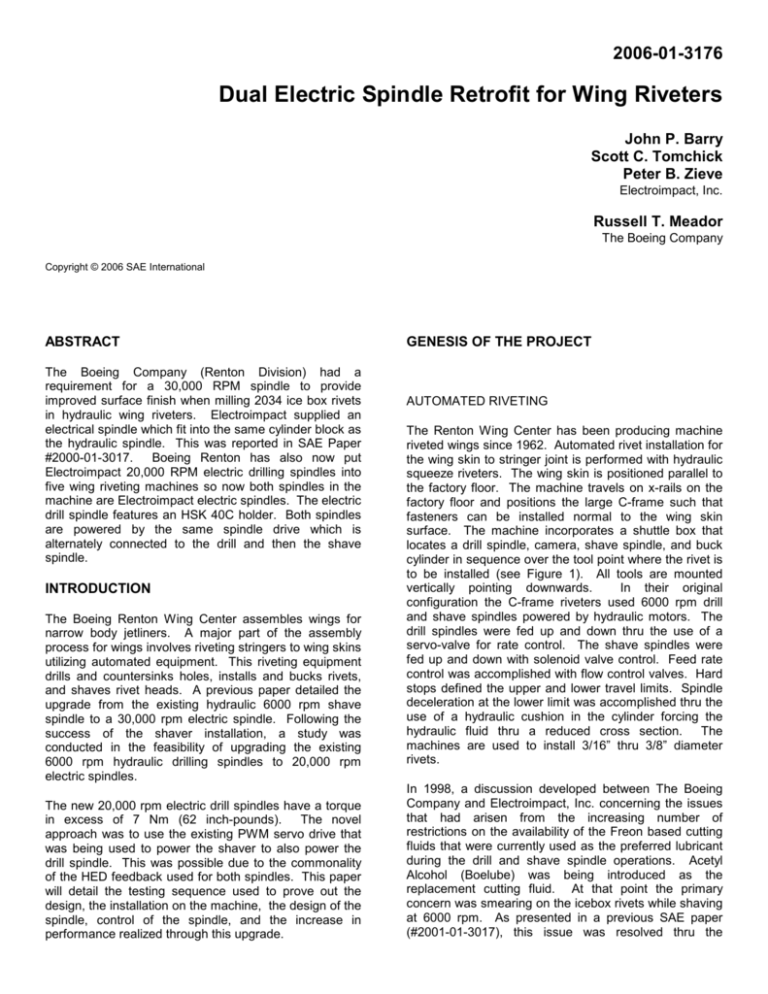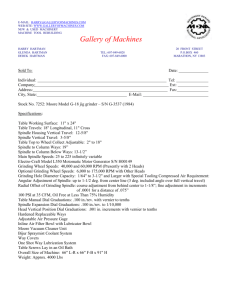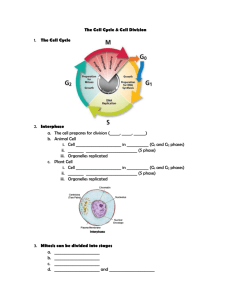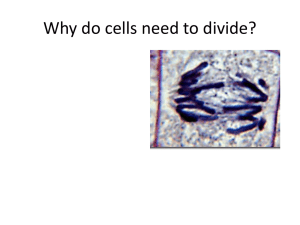Dual Electric Spindle Retrofit for Wing Riveters
advertisement

2006-01-3176 Dual Electric Spindle Retrofit for Wing Riveters John P. Barry Scott C. Tomchick Peter B. Zieve Electroimpact, Inc. Russell T. Meador The Boeing Company Copyright © 2006 SAE International ABSTRACT The Boeing Company (Renton Division) had a requirement for a 30,000 RPM spindle to provide improved surface finish when milling 2034 ice box rivets in hydraulic wing riveters. Electroimpact supplied an electrical spindle which fit into the same cylinder block as the hydraulic spindle. This was reported in SAE Paper #2000-01-3017. Boeing Renton has also now put Electroimpact 20,000 RPM electric drilling spindles into five wing riveting machines so now both spindles in the machine are Electroimpact electric spindles. The electric drill spindle features an HSK 40C holder. Both spindles are powered by the same spindle drive which is alternately connected to the drill and then the shave spindle. INTRODUCTION The Boeing Renton Wing Center assembles wings for narrow body jetliners. A major part of the assembly process for wings involves riveting stringers to wing skins utilizing automated equipment. This riveting equipment drills and countersinks holes, installs and bucks rivets, and shaves rivet heads. A previous paper detailed the upgrade from the existing hydraulic 6000 rpm shave spindle to a 30,000 rpm electric spindle. Following the success of the shaver installation, a study was conducted in the feasibility of upgrading the existing 6000 rpm hydraulic drilling spindles to 20,000 rpm electric spindles. The new 20,000 rpm electric drill spindles have a torque in excess of 7 Nm (62 inch-pounds). The novel approach was to use the existing PWM servo drive that was being used to power the shaver to also power the drill spindle. This was possible due to the commonality of the HED feedback used for both spindles. This paper will detail the testing sequence used to prove out the design, the installation on the machine, the design of the spindle, control of the spindle, and the increase in performance realized through this upgrade. GENESIS OF THE PROJECT AUTOMATED RIVETING The Renton Wing Center has been producing machine riveted wings since 1962. Automated rivet installation for the wing skin to stringer joint is performed with hydraulic squeeze riveters. The wing skin is positioned parallel to the factory floor. The machine travels on x-rails on the factory floor and positions the large C-frame such that fasteners can be installed normal to the wing skin surface. The machine incorporates a shuttle box that locates a drill spindle, camera, shave spindle, and buck cylinder in sequence over the tool point where the rivet is to be installed (see Figure 1). All tools are mounted vertically pointing downwards. In their original configuration the C-frame riveters used 6000 rpm drill and shave spindles powered by hydraulic motors. The drill spindles were fed up and down thru the use of a servo-valve for rate control. The shave spindles were fed up and down with solenoid valve control. Feed rate control was accomplished with flow control valves. Hard stops defined the upper and lower travel limits. Spindle deceleration at the lower limit was accomplished thru the use of a hydraulic cushion in the cylinder forcing the hydraulic fluid thru a reduced cross section. The machines are used to install 3/16” thru 3/8” diameter rivets. In 1998, a discussion developed between The Boeing Company and Electroimpact, Inc. concerning the issues that had arisen from the increasing number of restrictions on the availability of the Freon based cutting fluids that were currently used as the preferred lubricant during the drill and shave spindle operations. Acetyl Alcohol (Boelube) was being introduced as the replacement cutting fluid. At that point the primary concern was smearing on the icebox rivets while shaving at 6000 rpm. As presented in a previous SAE paper (#2001-01-3017), this issue was resolved thru the installation of an electric 30,000 rpm Electroimpact shave spindle (see Figure 2). The spindles are powered by a brushless DC permanent magnet servo motor. Spindle speed is powered by an analog 150 amp spindle drive. A GE 9030 PLC was used to control the operation of the spindle drive and to perform error handling functions. The shave spindle was designed to fit inside of the envelope of the existing hydraulic ram used as the feed axis of the shave spindle operation. The electric shave spindles were installed on 9 C-frame riveters at the wing center. In 2000, a subsequent discussion of implementing an electric drilling spindle similar to the shave spindle ensued. At that point The Renton wing center was beginning the process to upgrade the controls and processes on five wing riveters. The upgrades would include replacement of the Allen-Bradley controls, hydraulic servo control of the tool shuttle, hydraulic servo rivet upset, hydraulic servo drill approach and feed to depth, and inclusion of a high speed drill spindle. As presented in a previous SAE paper (#2004-01-2810). The following goals were defined • • • • • Drill all required holes at 20,000 rpm Fit drill spindle into existing spindle envelope Improve access to top of spindle Test process feasibility at Electroimpact facilities Control shave and drill spindles with the single existing spindle drive. APPLICATION REQUIREMENTS The drill spindle requirements to produce holes for 3/16” thru 3/8” diameter rivets were determined to be 7 Nm (62 inch pounds) of torque at 20,000 rpm. Maximum drilling thrust loads were determined to be 1800 N (405 pounds) for the maximum stack size of 35 mm (1.5 inch). Spindle Motor The shave spindle used a permanent magnet rotor that was 102 mm (4 inch) long (see Figure 3). In order to increase to the torque levels required for drilling, the rotor magnet length was increased to 152 mm (6 inch) (see Figure 4). To enable monitoring of the front bearing temperature, thermocouple wire was wound in the stator with the magnet wire. The thermocouple wire could not be routed outside the stator due to restriction of staying inside the existing envelope of the previous hydraulic ram. By definition, a brushless DC motor requires a noncontact method of motor commutation. This is typically achieved with a resolver or encoder. This application makes use of three HED sensors which enabled many beneficial features. In the presence of a North magnetic field of sufficient strength the HED sensor outputs 5 VDC. When the field strength drops below the required level, the signal drops to zero. The rotor shaft contains 4 magnetic pole pairs such that the output of the HED sensors is a square wave as the shaft rotates. The HED sensors are potted into the motor stator in a precise location enabling instant commutation with the drive. Resolver and encoder commutation require a homing sequence to teach the spindle drive the location of the magnets on the rotor relative to the output of the feedback device. The HED sensors directly detect the presence of the magnets on the rotor which is the only information that the drive requires to determine in which sequence the motor stator windings will need to be energized. Spindle Bearings The spindle bearing size was increased from the size used on the shave for several reasons. The thrust requirements for drilling were 1800 N (405 pounds). The preferred tool holder interface for the spindle was also defined as the Briney Tool HSK 40 A shrink fit tool holder. The larger bearing size being required to provide the larger thrust and accommodate the larger tool holder resulted in the top speed being limited to 20,000 rpm. With the advent of silicon-carbide hybrid ceramic bearings it is possible to achieve NDm values over 1.2e6. However, in this application there were also numerous issues with spindle cooling. Spindle Stiffness Fundamental to the design of any spindle are static and dynamic stiffness. A spindle that lacks rigidity can result in countersink chatter. To optimize the stiffness of the spindle shaft, the permanent magnets of the rotor are mounted directly on the spindle shaft. Several factors had to be considered before this could be done. The preferred alloy for shafts made with the HSK interface is 8620 alloy steel that is carburized during heat treat to achieve the high surface hardness (700 to 800 HV) required to bear the large contact stresses at the tool holder interface. The carbon content is detrimental to the magnetic permeability of the shaft. In order for the highest field strength to develop in the rotor, a low carbon steel is required as backing material to project the field lines out towards the stator windings. The stronger magnetic field allows for better traction with the magnetic fields developed when current flows thru the stator windings. The solution was to mask the area where the magnets are mounted during the carburizing process. As a result the high alloy 8620 served as a proper backing material for the magnets and the remainder of the spindle shaft had the high hardness required for the HSK interface and the location of the bearings on their mounting surfaces. The spacers between the lower bearings were also designed to improve stiffness. On previous spindle designs, the length of the bearing spacers is similar to the thickness of the bearings used. This is advantageous to reduce the overall length of the spindles. On the drill spindle, the length of the spacers was increased to 1.5 times the bearing thickness. This increases the effecting length of the bearing pack which resists moment loading that would deflect the spindle sideways. The increase in length of the bearing spacers also improves the dissipation of heat from the bearings by providing more surface area for the heat to conduct to the atmosphere. Spindle Cooling Spindle cooling on the drill spindle was more complicated than that of the previous shave spindle. On the electric shave spindle cooling is achieved by porting clean dry air into the top of the spindle and exhausted out just above the front bearing housing. Because of the increased size of the lower spindle bearings of the drill, it was not possible to vent the cooling air out of the bottom of the spindle. The solution was to direct the cooling air thru passage cut into the inside diameter of the ram, past the outside diameter of the stator. At the lower edge of the stator the air is directed into the space between the stator and shaft of the spindle where the air flows back up to the top of the spindle. Putting positive air pressure into the cavity of the spindle can have detrimental effects on the lower spindle bearings. Positive pressure will vent thru the front bearing housing with the possible result of pushing the bearing grease out the front of the spindle. The solution was to install a pneumatically actuated vacuum on the exhaust port of the cooling air. However, if an excessive vacuum is pulled on the spindle cavity, the effect will be to draw the air at the lower end of the spindle up into the spindle bearings. This effect is even more destructive due to the nature of the air at the bottom end of the spindle being contaminated with cutting oil and aluminum chips. To set the proper vacuum level, a plastic bag is placed over the bottom of the spindle ram, a flow restrictor on the supply of the cooling air to the spindle is then adjusted until the bag is slowly filling. Using this simple method with commonly available tools, the proper setting is easy to achieve. Tool Holder Interface and Cutter Just as the restrictions in the use of Freon were the driving force for the development of the 30,000 rpm shave spindle, improvements in tool holders and cutters have driven the development of the 20,000 rpm drill spindle. When the wing riveters were introduced the standard tool holder was a pendulum collet and the typical cutter was made from high speed steel. Within the last 10 years, the availability of HSK tooling for high speed machining has increased dramatically. The HSK standard that was developed in Germany provides a robust tool holder designed for high speed machining. The pull in force on the tool holder increases with higher spindle speeds. The dual locating surfaces on the shaft taper and face allow for increased dynamic stiffness as well as lower tool run out. For this spindle, the Guhring 4-point manual HSK 40C clamping cartridge was chosen. A manual clamp cartridge was chosen over a power drawbar for several reasons. The manual cartridges are a much simpler mechanism, they provide higher pull in force for the tool holder, they do not require external pneumatic or hydraulic systems for actuation, and they are much lower in cost. Tool changes are performed with the use of a tee-handled hex wrench. The actuation screw on the standard manual clamp cartridge comes with a double ended screw. The disadvantage is that if the operator installs the wrench in the wrong end of the actuation screw, the cartridge could be tightened when the operator is attempting to remove the tool holder. This problem was solved by putting a drop of epoxy in the side opposite the correct access point. The interface between the tool holder and the cutter has also seen recent improvements. Heat shrink tool holders constitute the most rigid coupling possible in a two piece joint. Recent introductions in the market allow the heat shrink process to occur in seconds. The typical aerospace drills are now solid carbide cutters which allow high speed machining at 500 m/min (1500 sfpm) surface speeds with negligible cutter wear. Where high speed steel cutters are run at significantly lower surface speeds and are regularly replace due to wear after as few as 1000 holes, carbide cutters cut more higher quality holes faster. However, the carbide cutters do require lower spindle run out (10 microns max) to achieve these benefits. The new spindle meets these requirements. Testing at Electroimpact Facility To insure the integrity of the drilling unit and to avoid the costly installation and disruption of installing a drilling unit on a wing riveting machine, it was agreed that the drilling process should be duplicated at Electroimpact facilities for testing purposes. Boeing provided the hydraulic cylinder block that would allow the drill spindle installed in the ram to be cycled up and down during the drilling process. The cylinder block was installed on the face of a knee mill (see Figure 5) that provided the stiff coupling between the spindle and the coupon and also allowed the coupon to be positioned for multiple holes to be drilled. Positioning of the feed axis was achieved thru the use of a small hydraulic pump, solenoid, and PLC. Lube application was performed by the lube pumps currently in use on the production machines. For the dual drive switching part of the tests, solid state relays were chosen to minimize noise transmission and increase operating life. Solid state relays also do not exibit mechanical bounce which is a common occurrence in mechanical relays. On the power side the spindles are driven by three phase power. Two of the phases were forked to the two spindles with solid state relays (see Figure 6). All three phases are not forked because this could prevent a solid state switch from getting a reliable zero crossing so one phase of the drive is common to one phase of each spindle winding.The HED feedback signal was switched using relays with gold plated bifurcated contacts allowing for maximum signal transfer and low impedence. No problems were encountered with the signal relays during testing or in production. A test bench was setup with two spindles. On switching back and forth it was observed that the selected spindle drove reliably but it was also observed that the “off” spindle was twitching. Several different styles of solid state relays were tried and for solid state relay supplied by the Crydom Corporation, the twitching was gone. The only significant difference between the Crydom SSRs and the other units was that the Crydom unit does not use an intenal snubber. The system can now be run without the “off” spindle twitching. INTERFACE WITH THE EXISTING MACHINE The main incentive for upgrading to 20,000 rpm spindles was that hole quality and drill life degraded dramatically when Freon cutting fluid was replaced with acetyl alcohol. Experience on other equipment indicated that high speed drilling with carbide cutters under these conditions was beneficial. In addition, the planning was in progress to upgrade the riveting machines and thus provided the opportunity to include high speed drilling in the design of the upgrade. The riveter upgrade was presented in a previous SAE paper (#2004-01-2810). Cable Routing For the shaver retrofit, the cables were run inside the top arm of the wing riveter to a junction box on the end of the C-frame. With the removal of the hydraulic drill spindle and motor, there was an large increase in available space on the side of the C-frame opposite to the machine operator. On the shaver installation, the hydraulic apparatus on the side of the C-frame blocked access to the top of the spindle making installation and maintenance more difficult. The mechanic only had access from inside the C-frame above the spindle. With the hydraulics removed it became possible to route the cables directly out the side of the C-frame where access was achieved while standing on the existing platform. 3. PLC enables the spindle drive and commands spindle rpm to ramp up from the speed given at the analog tachometer output to the desired cutting speed for the drill spindle. 4. PLC monitors analog tachometer output and the drill starts to feed when the spindle reaches 90% of the commanded RPM. 5. When hole is completed, the spindle drive is disabled. 6. Machine proceeds to squeeze rivet. While this is occurring, the contactors are switched disconnecting the drill spindle and connecting the shave spindle to the spindle drive. 7. Machine PLC reads current shave spindle velocity from the analog tachometer output on the spindle drive. 8. The shave spindle accelerates to 28,500 RPM in 1.5 seconds. The trigger to start occurs while the rivet is being squeezed. 9. PLC enables the spindle drive and commands spindle rpm to ramp up from the speed given at the analog tachometer output to the desired cutting speed for the shave spindle. 10. PLC monitors analog tachometer output and the shaver starts to feed at any point after the spindle reaches 90% of the commanded RPM. 11. When the shave cycle is completed, the spindle drive is again disabled. This allows the shave spindle to coast. 12. When the shave operation is completed, the contactors are switched disconnecting the shave spindle and connecting the drill spindle to the spindle drive. 13. The cycle then repeats. Mechanical Interface Spindle positioning of the feed axis is accomplished thru the existing hydraulic system with the addition of a magneto-strictive linear positioning feedback to the Delta Computer hydraulic controller. This is an absolute device and therefore homing the drill feed axis is not required. The cutting lubricant is sprayed in a mist at the cutter for 0.5 seconds before the drill starts to feed. CONCLUSION Electrical Interface Because of the nature of the HED spindle feedback for commutation detailed above, it became possible to control the drill and shave spindle with a single drive. The power and signal leads to the spindles are routed thru a set of contactors to the drive. The cycle is as follows 1. Command to spin up the drill occurs when the machine cycle starts. The spindle ramp is set so that it takes 1 second to reach 20,000 RPM from a stopped condition. Acceleration time is shorter if the spindle is still rotating. 2. Machine PLC reads current drill spindle velocity from the analog tachometer output on the spindle drive. Many benefits have been realized with the switch from 6000 rpm hydraulic spindles to 20,000 rpm electric drill spindles. Drilling feed rates increased from 36 in/min to 140 in/min. Removal of hydraulic spindle motors and the ancillary hoses, solenoids, and switches resulted in a cleaner machine. The new drill spindle has allowed The Boeing Company to realize the full benefits of recent developments in HSK tooling, heat shrink tool holders, and carbide cutters without purchasing an entire new machine. ACKNOWLEDGMENTS The authors would like to thank Eamon Nelly of Electroimpact and Bryan Conley of The Boeing Company for their assistance bringing this project to a successful conclusion. REFERENCES 1. Barry, John, Zieve, Peter, Meador, Russell and Conley, Bryan, “Electric 30,000 RPM Shave Spindle for C Frame Riveter and High Performance Compact Aerospace Drill,” 2000 SAE Aerofast, 00FAS-13017. 2. Meador, Russell T., “Retrofitting Gemcor Wing Riveters with Hydraulic Servo’s”, 2004 SAE Aerofast, SAE Paper #2004-01-2810. CONTACT Micron: 1x10e-6 meters (0.00004 inches) Electroimpact, Inc. www.electroimpact.com NDm: Speed of a bearing. Equal to average bearing bore in millimeters times the speed in RPM. John P. Barry – Project Engineer Johnb@electroimpact.com PLC: Programmable Logic Controller. Digital controller which uses ladder logic or STL to control analog and digital inputs and outputs. The Boeing Company www.Boeing.com Russell T. Meador – Facilities Services Engineer Russell.t.meador@Boeing.com PWM: Pulse Width Modulation. Modern spindle drives use PWM to transform a DC voltage to the frequency required to rotate the motor at the commanded speed. The amount of power sent to each of three windings is varied with the width of the square wave. DEFINITIONS, ACRONYMS, ABBREVIATIONS APPENDIX Freon: A Chlorofluorocarbon (CFC) based cleaner. A trade name of the DuPont Corporation. HED: Hall Effect Device. A sensor that emits a square pulse train when excited by alternating north and south magnetic poles. EXIT POINT FOR CABLES. C-FRAME. OPERATOR ON OPPOSITE SIDE OF MACHINE. TOOL POINT. FIGURE 1: WING RIVETER. FIGURE 2: HIGH SPEED SHAVER ASSEMBLY DRAWING FIGURE 3: HIGH SPEED DRILL SPINDLE ASSEMBLY DRAWING FIGURE 4: FOUR POLE PAIR MAGNET ROTOR ELECTRICAL CABLES TO SPINDLE DRIVE CYLINDER BLOCK HARDSTOP AND TOOL POINT. KNEE MILL COUPONS BOLTED TO TABLE FIGURE 5: TEST SETUP FOR SPINDLE EVALUATION. FIGURE 6: ELECTRICAL SCHEMATIC.






